
August 8-14 live war map: Drama on Pokrovsk -Toretsk front and euphoria near Kursk
As Russian forces make daily advances in the Donetsk region, Ukrainian troops are also pushing forward in the Kursk region. Although overall attacks have decreased over the past week, fighting has intensified this week, particularly around Pokrovsk and Lyman
The destruction of two Russian airfields and a significant stockpile of guided bombs has led to a decrease in Russian bombing along the defense line, with some areas experiencing a halt in air attacks for several days. The southern front has largely stalled, and there has been a reduction in offensive actions in other sections. Key areas of focus include the front around Siversk and the southern part of the Luhansk region. Despite substantial efforts, Russian troops have made little progress in these areas, much like the situation in Chasiv Yar, where Ukrainian Defense Forces are maintaining their defensive positions along the canal.
Russian troops enter Toretsk, New York braces for encirclement
From the village of Pivnichne, Russian troops have advanced 1 km along Dzerzhynskoho Street, bypassing the spoil heap of the Pivnichna mine. If this breach is not quickly addressed, Russian troops could gain the ability to assault the spoil heap from multiple sides. Occupying this spoil heap would give them fire dominance over Tsentralna Street, where Ukrainian Defense Forces are holding the line. Essentially, controlling the spoil heap would create a gateway for Russian forces into the city.
Russian forces continued to expand their control on the flanks: they completed the occupation of the village of Pivdenne and connected with forces advancing along the eastern flank of New York. The Ukrainian forces were forced to retreat to the system of ponds to avoid encirclement.
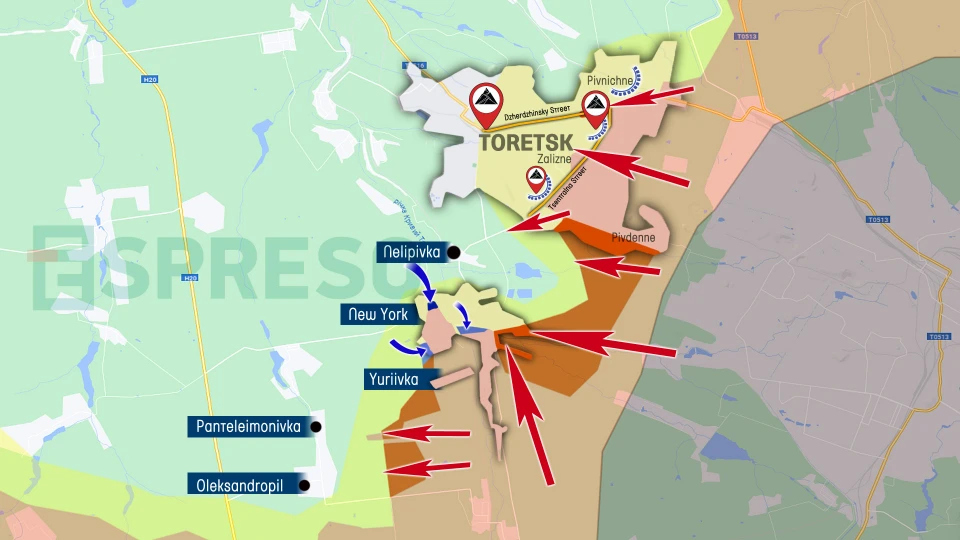
Photo: Espreso Map of hostilities for August 7-14
Therefore, the occupying Russian forces have seized control of the outskirts of Toretsk and New York from the left flank. They are now poised to advance towards the town and initiate an encirclement of the settlement, with their movement extending from Zalizne to Nelipivka
In the central part of New York, the Ukrainian Armed Forces managed to conduct a local counteroffensive and retake the area around the school, but these were the only successes. On the western flank, the Russian military significantly expanded their zone of control between Yurivka and Panteleimonivka. The Ukrainian garrison in Oleksandropil, which is located on a dominant height and has been defending the road to Kostiantynivka throughout the summer, is in a rather difficult position. If Oleksandropil is surrounded, this section of the front may again change dynamically, not in Ukraine's favor.
In the coming days, Russian forces will continue to advance on the western outskirts of New York in order to threaten the encirclement of the village and force Ukrainian Defense Forces to withdraw.
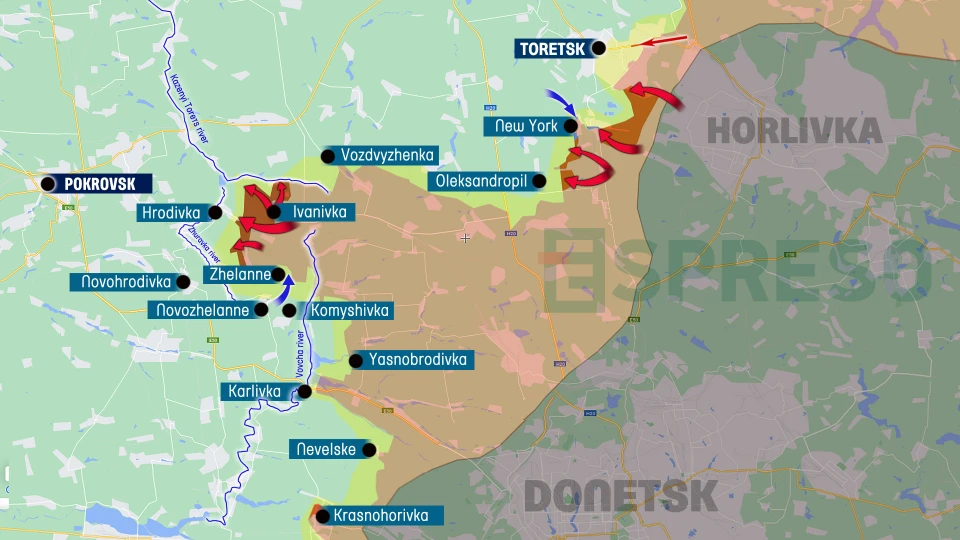
Photo: Espreso Map of hostilities for August 7-14
Pokrovsk hell
Over the past week, the frequency of attacks in the Pokrovsk direction had decreased by 30-40% daily. However, on Monday, attacks surged to a record high of 50. This reduction in intensity allowed Ukrainian Defense Forces to maintain control over half of the nearly encircled village of Zhelanne. Ukrainian soldiers also successfully repelled advances on the eastern bank of the Vovcha River, between Novoselivka Persha and Yasnobrodivka, and thwarted Russian attempts to break through in Vozdvyzhenka—the last barrier before the Pokrovsk-Kostiantynivka road—and Karlivka, which is preventing a push towards Selydove. Additionally, Russian forces failed to advance further along the railroad towards Novohrodivka.
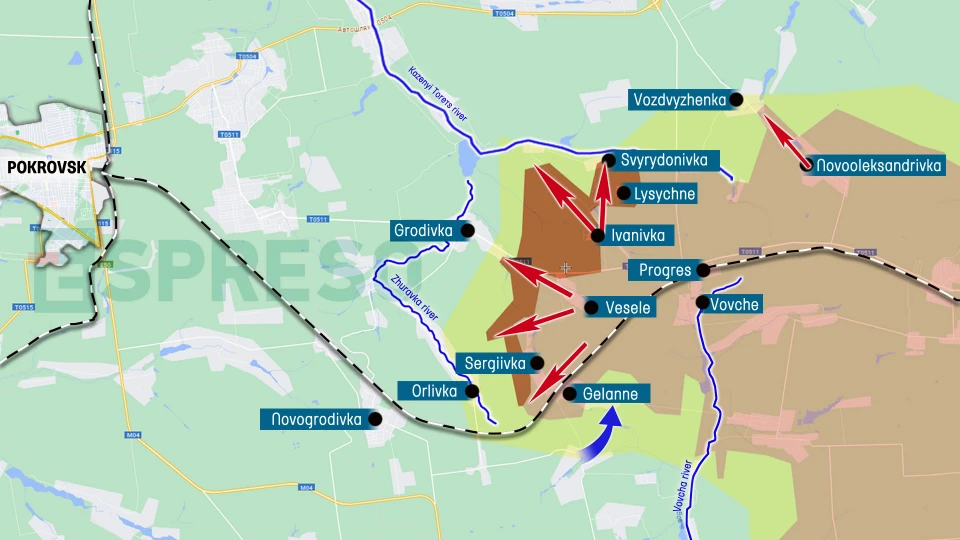
Photo: Espreso Map of hostilities for August 7-14
The only success for Russian troops has been the complete occupation of Serhiivka and an expansion of their control along the left bank of the Kazennyi Torets River, with the capture of Svyrydonivka and Lysychne. Ukrainian forces have fully withdrawn to the right bank of the river and are now holding the defensive line in the key fortification area of Hrodivka. Russian troops have commenced an assault on Hrodivka, which could potentially grant them access to the rear of Ukrainian Defense Forces and open a route to Myrnohrad. The battle for Hrodivka is set to be a decisive confrontation in the Pokrovsk direction
Vuhledar is getting closer
The offensive along the Vuhledar-Kostiantynivka (village) road has persisted, with Russian forces achieving success for the third consecutive week. They have succeeded in pushing Ukrainian Defense Forces back from several positions, driving them completely behind the road, which has now become the front line and lost its logistical significance. Meanwhile, Russian troops have advanced into the southeastern streets of Kostiantynivka, expanding the gray zone to cover most of the eastern part of the village and the entirety of neighboring Paraskoviivka
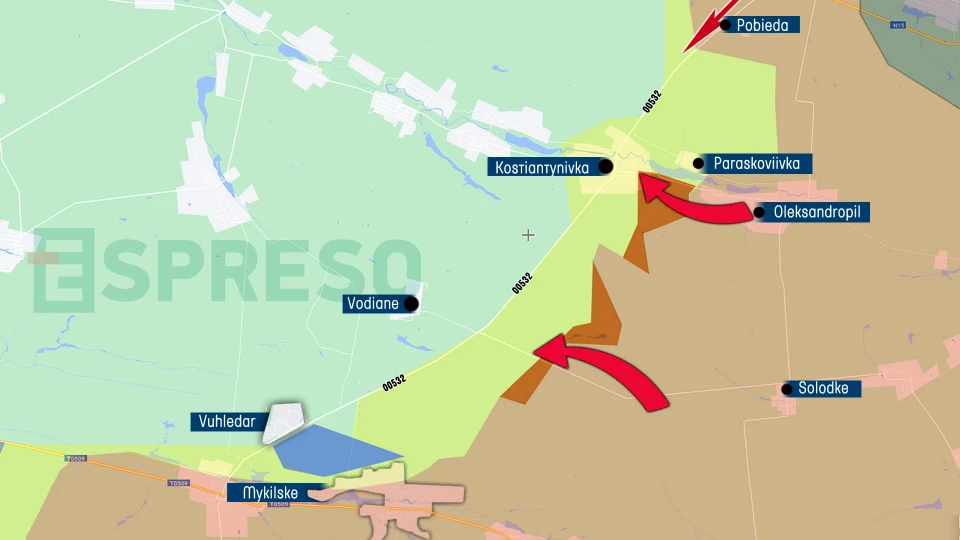
Photo: Espreso Map of hostilities for August 7-14
Offensive on Kupiansk
Although the number of battles in the Kupiansk direction decreased by 30%, Russian troops managed to advance not only one kilometer west of Pishchane but also 2.5 kilometers from Tabaivka. At the same time, on the left flank of the offensive, they significantly expanded the zone of control between the previously occupied villages of Berestove and Novoselivske, and also advanced almost 4 km to Stelmakhivka and began storming its northern outskirts. In this way, they ensure the width of the front before attacking the villages that cover the southern flank of Kupiansk.
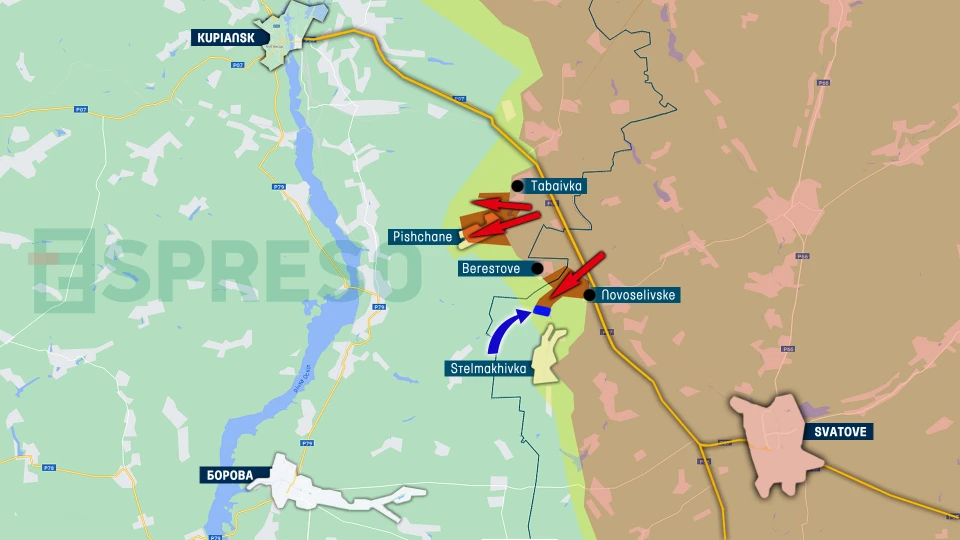
Photo: Espreso Map of hostilities for August 7-14
Kursk shock and panic
It has been exactly one week since Ukrainian forces entered Russian territory. During this period, the presence of unknown 'good forces' was confirmed through statements by Syrskyi and Zelenskyy. The week of strategic information silence by Ukraine’s General Staff and other government branches has allowed the Ukrainian Armed Forces to induce shock and panic among Russian troops, achieving advances in five areas of the Kursk region and in Belgorod.
Much of the data we analyze originates from Russian sources, which are clearly unreliable. Ukrainian military personnel, on the other hand, provide brief updates on social media that are 2-3 days old, intentionally misleading their enemy
Russian local authorities acknowledged the occupation of 28 settlements, while the military estimated around 50. President Zelenskyy officially reported that 74 towns and villages are under Ukrainian control. However, only the Ukrainian General Staff knows the exact locations where the Ukrainian Armed Forces are fighting and advancing without resistance, making our map largely approximate, showing only confirmed areas of activity.
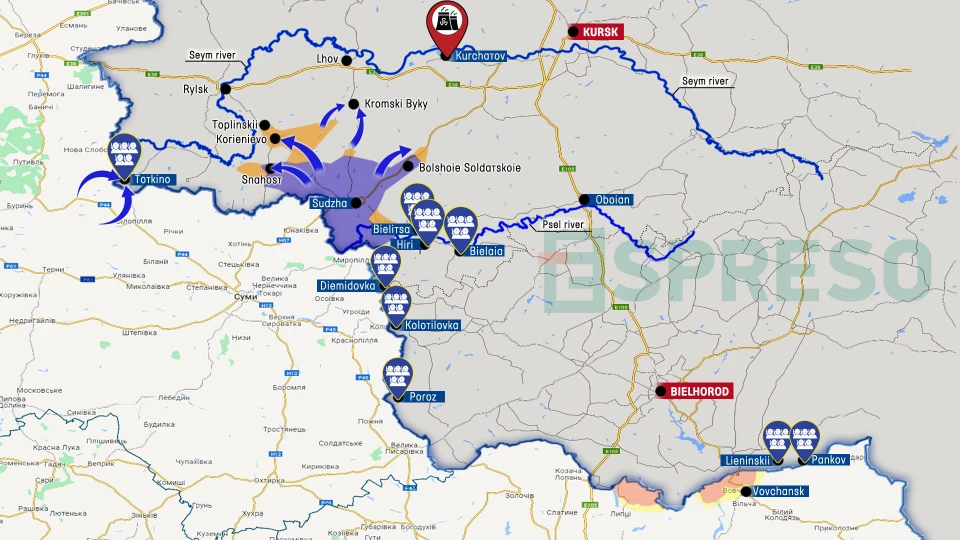
Photo: Espreso Map of hostilities for August 7-14
On the first day of the offensive, the Ukrainian Armed Forces captured Sudzha. They then divided into multiple small units, advancing north, west, and east to flank and encircle their enemy. Ukrainian troops made significant progress, advancing 35 km northeast to the district center of Korenevo, where they began encircling the town from the north and south. Concurrently, they liberated all villages along the border from Sudzha to Snyagost. This advance in the corridor between the border and the left bank of the Seym River is expected to continue towards the Ukrainian border near the Tetkino crossing. Notably, around 1,000 Russian soldiers stationed in this area, who were preparing an offensive on Sumy, may soon find themselves encircled by Ukrainian forces moving from Ukraine towards those advancing from Sudzha. Russian forces lost contact with Tetkino several days ago
North of Sudzha, the Ukrainian Armed Forces are advancing in several directions toward the cities of Lgov and Kurchatov. Given that the Russians themselves acknowledged that Ukrainian forces are now within 40 km of Kursk, it is likely that the Ukrainian forces have gotten even closer to these cities. However, it's currently only confirmed that fighting is taking place near the village of Kromskiye Byki on the Lgov front, and the village of Bolshoye Soldatskoye has come under Ukrainian control. Considering the direction of the Ukrainian advance, it's logical to assume that they aim not only to cut the Rylsk-Kursk highway but also to reach the banks of the Seym River.
East of Sudzha, the Ukrainian advance has been more modest and met with the strongest Russian resistance, as the threat of cutting the Belgorod-Kursk highway would be a national catastrophe for Russia. Despite this, Ukrainian forces have pushed at least 18 km to the village of Belitsa, advancing along the right bank of the Psel River. They also managed to cross the river and capture several villages on the left bank. Additionally, Ukrainian reconnaissance units have been spotted in the villages of Demidovka, Kolotilovka, and Poroz along the border, and likely in more locations. A potential shock for the Russians could be a Ukrainian advance east of Vovchansk, where Ukrainian forces have already been recorded in the villages of Pankov and Leninsky.
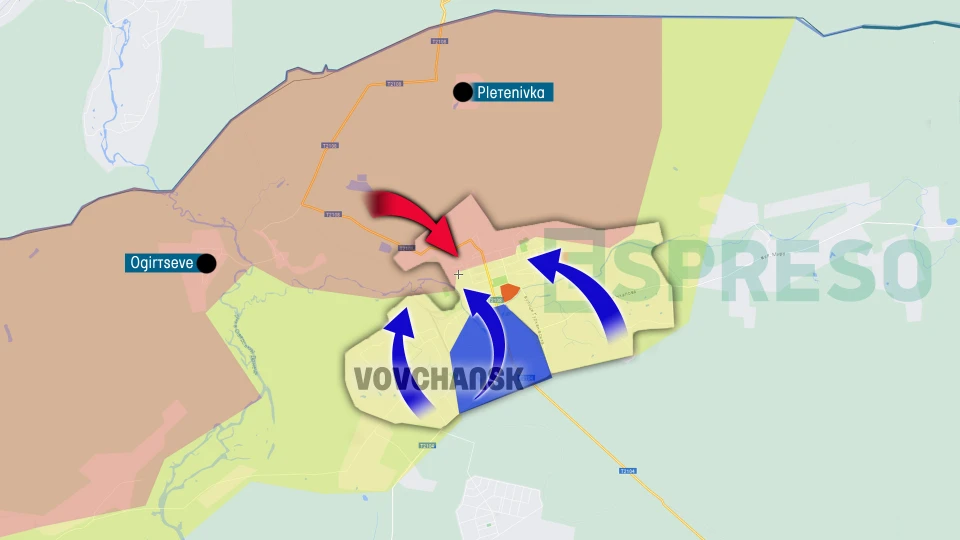
Photo: Espreso Map of hostilities for August 7-14
One of the potential objectives of the operation in the Kursk region might not only be to halt the Russian advance on Vovchansk but also to encircle and destroy the entire Vovchansk group. Currently, Ukrainian forces have launched a strong offensive in Vovchansk itself, pushing Russian troops out of the city. However, significant support from the Belgorod region could accelerate this process and ignite panic in Belgorod. A new wave of thousands of refugees would likely collapse military logistics in this direction.
At this moment, it's evident that Russian forces are pulling their reserves back into Russia from all frontlines, except for Donetsk, where they still hope to maintain their offensive momentum. Meanwhile, Ukrainian forces are daily establishing a new demilitarized zone along their northeastern border between the Psel and Seym rivers.

Photo: Espreso Map of hostilities for August 7-14
Airfield destruction in Russia
Following the destruction of the Morozovsk airfield, Ukrainian forces carried out another substantial strike on the Lipetsk airfield. This attack demolished warehouses containing 700 sets of aviation bomb control modules and a significant, though undisclosed, quantity of KAB-250, KAB-500, and KAB-1500 bombs. Additionally, the Ukrainian forces targeted a power infrastructure facility, a refinery, and air defense positions. Five days later, they struck two more airfields in Voronezh—Borisoglebsk and Baltimore—as well as the Savasleyka airfield in Nizhny Novgorod, which is used by the MiG-31K, the carrier of the Kinzhal missile. Details of these strikes are still being clarified. Although the Russian General Staff claimed to have shot down 117 drones, at least 10 explosions were reported in Savasleyka, likely resulting in damaged aircraft.
The maps were created based on information from the Ukrainian Armed Forces' General Staff and other open and verified sources. However, they are not perfectly accurate and only provide a conditional representation of trends in the combat zone.
- News











































